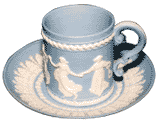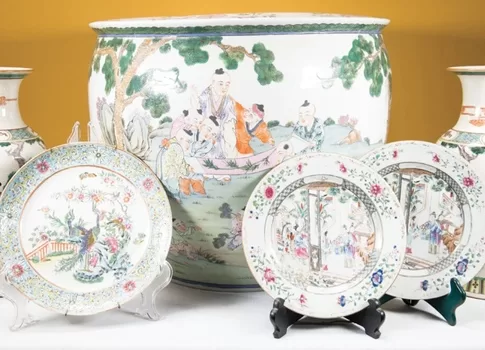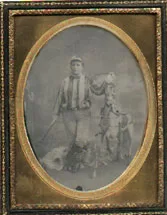On this page: Neolithic Pottery ° Aegean Pottery ° Chinese Ceramics ° Central and South American Pottery ° Egyptian Pottery ° English Ceramics ° European Ceramics ° European Ceramics ° Japanese Ceramics ° Korean Ceramics ° North American Pottery ° Some Well-Known Ceramics Factories
Neolithic Pottery
Cultural evolution around 10,000 B.C. called for new implements. The idea of clay fashioned into a shape and hardened by fire may have been suggested by the attempt to protect a basket from fire by smearing clay on it before placing it over the flames.
This early pottery was made by hand, was simple, rugged and decorated with concentric lines, spirals, dots, etc., the universal basic motifs. The earliest pottery may have come from the Tigris Euphrates Valley.
Advertisement:
Aegean Pottery
The island of Crete was the center of the early (3000-1100 B.C.) pottery industry as it was the gateway to 3 continents. The early wares were robust in shape with a lusterous black ground and geometric designs of white, yellow and red.
As time went on, the designs became naturalistic using sea life, grasses, birds, etc. About 1100 B.C. the Greeks took over the pottery trade and developed it further. The Greek potter concentrates on his chief concern, man. Probably no other people have used the human figure so preponderantly in ceramic decoration as the Greeks.
Chinese Ceramics
Pottery of the Neolithic type started about 3000 B.C. in Kansu, the western gateway to China. There is evidence that this pottery shows Sumerian influence.
The Chinese produced hard-bodied, unglazed ware as early as the Chu dynasty 1100-256BC. In the Han dynasty, they used powdered petuntse as a glaze on a hard-fired greyish colored body. These wares were called proto-porcelain.
The Tang horses were another example. There is evidence of a translucent ware by 883. However, the Chinese define porcelain as “resonant material,” while the Europeans define it as “translucent.”
In addition to all of the wares made for its own people, the first direct trade between Europe and China began in 1517, and the earliest porcelain designed for export to the West may date from that period. In 1557 the Portuguese established a permanent trading base at Macao.
Later, most shipments were handled by the East India Company. Most early pieces were purely oriental in shape and decoration. But, by the 1630’s when stable trade connections had been established, Dutch merchants ordered and received special forms designed for the European needs and customs. That was just the beginning!
Central and South American Pottery
The pottery of Mexico and Central America was mostly of geometric patterns done in red, brown and white slips. They also used a unique technique of covering a pot with wax, cutting away the design which was covered in pigment and when fired, the wax burned away leaving the pigment on the unwaxed portion.
The Mayas made good pottery from c. 600 BC to 1000 AD; no Aztec pottery has been definitely identified prior to c. 1325.
European motifs began to appear in the 16th c. after the Spanish conquest. From 100 B.C. to 600 A.D., on the Peruvian coast, the Mochicas were makers of a lively realistic sculptural pottery which showed great imagination.
The daily activities of these people were translated into their clay forms which constitute the chief source of our knowledge of these people and their art. This was continued by the Chimu and the Inca potters. The Nazcas on the southern coast of Peru were also significant potters from c. 500-800 AD. just the beginning!
Egyptian Pottery
The Egyptians used glazed tiles for wall decoration since prehistoric times. A ware made from sand and some kind of cement as a binder with a green to blue glassy glaze was made from c. 3300 to c. 30 BC. This ware was not faience or even pottery.
Egyptian pottery made during the Fatimid dynasty (969-1171) included some lustre ware, sgraffito ware and pieces with a dark brown highly fired glaze. The turquoise blue color of the glaze came from copper.
English Ceramics
English delftware from the mid 16th c. is highly prized today. There were other early earthenware and stoneware factories throughout England.
During the 17th and early 18th c., due to the East India Company, export wares from China and Japan flooded the English market. In the mid 18th c. several factories commenced producing soft paste porcelain, and by about 1800, the addition of a stabilized proportion of bone ash to the formula commenced the production of “bone china” which is still made today.
The porcelain wares produced at Plymouth from 1768-1770 and subsequently at Bristol from 1770-1781, were hard paste. From 1781- c.1813, New Hall continued making a type of hard paste which was fired at lower temperatures than the real hard-paste and thus it showed none of the flaws associated with the Plymouth and Bristol versions.
European Ceramics
Before the invention of porcelain, the tableware of the wealthy was silver and faience, the poor using pewter and common earthenware. Many of these early European ceramics are covered elsewhere in your cheat sheet.
As with England, during the 17th and 18th c. export wares from China and Japan flooded the European markets. Medici porcelain (see below) is often credited as being the first porcelain produced in Europe, but this was short lived and was of a soft paste.
The collaboration of Johann Friedrich Bottger and Ehrenfried Walther von Tschirnhausen, under the aegis of Augustus the Strong, resulted in the discovery of proper clay and thus the first hard paste porcelain in Europe in Saxony in 1709, and the Royal Saxon Porcelain Manufacture was opened at Meissen in 1710.
Elsewhere in Europe, the Austrians acquired the hard paste formula in 1719, and a several French faience factories began experimenting with porcelain formulas. The Vincennes factory was founded in 1738, which launched the making of soft paste porcelain, moved to Sevres in 1753. A source of kaolin was found near Limoges in 1765, and by 1768, hard paste porcelain was in production.
Japanese Ceramics
The art of ceramics was not developed in Japan until the coming of Zen Buddhism and the tea ceremony. Their tea bowls were the height of simplicity to harmonize with the austerity of the ceremony.
Japanese porcelain began in 1616 when potter, Rhee Sam-bae, was brought to Japan from Korea, and found kaolin in Arita. Imari was hard paste porcelain made in Arita for export and shipped from the port of Imari, Japan. It was under glaze blue and over glaze iron red and gilt. Chinese Imari was copied from the Japanese.
Kakiemon, a polychrome enameled porcelain which was frequently copied in Europe, was another well-known manufacturer. Satsuma was a type of pottery made from the early 17th c. by Korean potters who settled in that town on the island of Kyushu.
Korean Ceramics
A grey stoneware was made during the Silla period (5th-6thc.), continues in various forms to the present. In the Koryo period (918-1392) they began making a simple celadon ware and by the middle of the 12th c. they developed an inlaying process of incising the body and filling in the design with underglaze copper and iron before firing. By the Yi period, 15th c., potters were making a white porcelain, often painted in underglaze blue, which was made for the aristocracy.
Near East (Persian/Islamic/Iznik) Pottery
Persia was a melting-pot of many influences: Babylonian, Assyrian, Achaemenian, Roman, Greek, Byzantine, Islamic and Chinese. For example, the opaque tin glaze was first developed by the Assyrians about 1000BC.
There was a lot of interaction between the Islamic potters and the Chinese, each pushing the other to greater innovation. The Islamic potters of the 9th c. found the white tin glaze a perfect canvas for ceramic decoration. Their blue (cobalt) decoration thus became the first “blue and white,” several hundred years before the Chinese made this ware famous.
Lustre ware was also first seen in Iraq in the 9th c. The Iranians made a coarse pottery in the 9th and 10th c. which was decorated in dull red and blue on a turquoise ground. In the 11th c. they developed a stone-paste body to imitate the Chinese white porcelain.
Persian potters also had an influence on those of Turkey, and Europe. The Iznik potters of 16th c. Turkey used a stone paste which also contained lead-rich frit. The decoration of much of this latter ware shows a strong Chinese influence but these potters excelled in natural floral designs.
North American Pottery
Of the many tribes inhabiting the area north of the Rio Grande, the Pueblo (village) people reached the highest cultural level. The introduction of some farming, possibly around 500AD, led to a more settled life and the building of homes and making of pottery.
Early on they were expert in making finely coiled baskets for household and burial use with geometric designs in red and black. It was a utilitarian art produced by women. Various bowls in different clays and designs were also made.
SOME WELL-KNOWN CERAMICS FACTORIES
AUSTRIA
Vienna – Hard paste porcelain, 1719-1864.
DENMARK
Copenhagen – Soft paste porcelain, 1759-65; hard paste porcelain, 1771- present.
ENGLAND
Bow – Soft paste porcelain which contained some bone ash. 1744-1776.
Bristol – Hard paste porcelain, 1770-81. (See Plymouth and New Hall below.) Not to be confused with Lund’s Bristol.
Chelsea – Perhaps the earliest of the English porcelain factories, 1745-84, soft paste porcelain. (Goat and Bee jugs from 1745 have survived. The best known periods were red anchor, 1753-58, and gold anchor, 1758-70.)
Derby – In 1770, the Derby factory bought the Chelsea factory and in 1876, the present day Royal Crown Derby Company was formed. A creamy bone paste was used in the Chelsea-Derby period.
Leeds – 1760-1878, creamware similar to that made by Wedgwood.
Lowestoft – 1757-1802, soft paste porcelain – not to be confused with Chinese Export Porcelain.
Lund’s Bristol – Soaprock porcelain, 1748-52. The factory was taken over by Worcester 1752.
Mason ware – Miles Mason (1752-1822) made earthenware, a hard porcelain and bone china; his son, Charles manufactured ironstone china beginning in 1813.
Minton – 1765-present, earthenwares, bone china and Parian porcelain.
New Hall – Hard paste porcelain, 1781-1812 and then bone china from 1812-35. This factory was owned by the partners who purchased the remaining rights to the hard paste patent of Richard Champion of Bristol (see Plymouth below).
Plymouth – Hard paste porcelain developed by William Cookworthy. This ware was the only”true porcelain” made in England. The factory was in operation from 1768-70 moving to Bristol in 1770-81. (The ware produced at Bristol during this period should not be confused with the Lund’s Bristol, a soaprock porcelain, made from 1748-52.) Early wares were decorated in underglaze blue, later wares in the Sevres style. Richard Champion, the former manager, took over as proprietor in 1774 at Bristol.
Ridgway – A number of factories owned by various members of the Ridgway family made earthenware, stoneware and porcelain from 1792 until 1959.
Rockingham – Earthenware, stoneware and porcelain manufacturers founded in 1745. From 1820 on, the overly ornate porcelain was made.
Spode – 1770- present, the Spode factory, founded by Josiah Spode, made earthenware, jasper, black Egyptian and black-printed wares. Josiah Spode, the son, turned to making porcelain and is credited with adding calcinated bone to the existing formula of china clay and china stone, thereby making what was to become the basic formula for bone china. Josiah Spode, III, is credited with the introduction of Spode felspar and stone china.


Wedgwood – The Wedgwood family began potting about 1612, and the company continues to the present. Josiah, who was born in 1730, began by making useful wares and experimenting with glazes, particularly green and yellow. He then developed creamware, which became the staple for years to come and in 1765, secured the patronage of Queen Charlotte and named a superior type of his creamware “Queensware”. Next came the basalt wares, and in 1776, he had developed a fine white artificial jasper for which he is most famous. Company also makes bone china.
Worcester – The First Period, or Dr. Wall period, 1752-83 produced a soapstone paste of the Lund’s Bristol type called soaprock porcelain, which made it closer to a true porcelain than many of the other English porcelain wares of the period. The thin glaze of this porcelain never crazed and there were many decorating styles. In 1783, Thomas Flight bought the factory for his sons and a new paste and glaze were introduced which lacked some of the translucency of the earlier body. Succeeding periods included Barr, Flight & Barr; Flight, Barr & Barr; Chamberlain & Co.; and in 1862, the Worcester Royal Porcelain Company Ltd. which exists today.
FRANCE
Chantilly – Soft paste porcelain, c. 1725-1800
Limoge – Hard paste porcelain, 1771 – present
Mennecy – Soft paste porcelain, 1734 – 1806
Quimper Faience – Earthenware from a factory in Brittany, established in the late 17th c.
St. Cloud – Soft past porcelain, c. 1690 – 1766
Samson – A French hard paste porcelain factory which, beginning in 1845, made reproductions of Chinese armorial porcelain, Meissen figures, gold anchor Chelsea and early Derby and Sevres.
Sevres – Production began in Vincennes and moved to Sevres – Soft paste porcelain (kilns closed by Napoleon in 1804) which gave way to hard paste porcelain, 1738 – present.
GERMANY
Berlin – Hard paste porcelain, 1751-1763. After 1763, it became KPM which continues in existence.
Meissen – Hard paste porcelain 1710 – present. The first factory to produce true porcelain in Europe.
Nymphenburg – Hard paste porcelain, 1753 – present.
HUNGARY
Herend – Hard paste porcelain, 1838 – present
ITALY
Capo-di-Monte – Soft paste porcelain, 1743-59
Doccia – Hard paste porcelain, 1735 – present
Medici Porcelain – In 1575,the Medici factory in Florence, Italy, tried to reproduce Chinese porcelain. The result was a soft paste porcelain which was made for a few years until the potter died and the formula was lost.
RUSSIA
Imperial Porcelain Factory – Hard paste porcelain, 1744 – present.
Gardner Factory – Hard paste porcelain, 1765 – present.
UNITED STATES
Bennington Pottery – A well-known American pottery factory which began with red earthenware and stoneware in the early 19th c.
Lenox – Factory started in Trenton, New Jersey in 1889. Began making American Belleek.
Newcomb Pottery – Art Nouveau earthenware from the pottery established by the college of that name in New Orleans, about 1900.
Rookwood Art Pottery – Founded by Maria Longworth Nichols in Cincinnati in 1880, it continued in existence until 1941.
Tucker Ware – Porcelain, but not hard paste, with floral decoration made in a Philadelphia factory from 1825-38.
References:
Warman’s English & Continental Pottery & Porcelain (3rd Ed)
by Al Bagdade
Marks & Monograms on European and Oriental Pottery and Porcelain
by Wm. Chaffers




